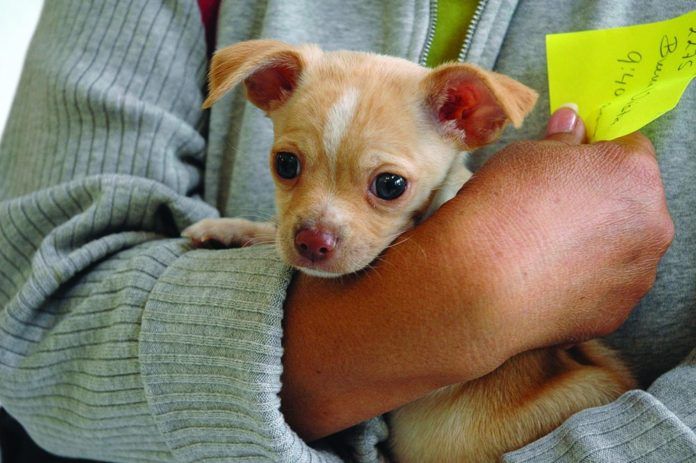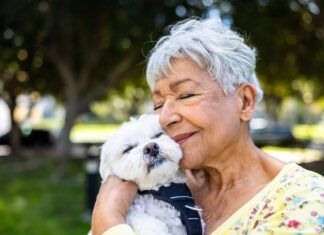You have a new puppy in your family. Hurray! What fun! It’s an exciting time, and one you want to share with your friends and family. And puppies are just adorable, so of course you want to take him everywhere with you! But according to your veterinarian, you shouldn’t take your puppy anywhere for a few months, until all of her “puppy shots” have been administered. On the other hand, you’ve also been told that it’s critically important for you to take your puppy to all kinds of places in order for her to become a well-adjusted, mentally healthy adult dog. What’s a good dog mom or dad to do?
Before you plop your little fluffball into his crate in the back seat of your car as you head out to run errands, you should consider these important dog-owner responsibilities:
– Protect your puppy from disease risk
– Consider your puppy’s physical safety
– Preserve your puppy’s psychological health
Taking your puppy to the wrong place at the wrong time can result in him becoming ill, injured, or fearful, sometimes with life-long consequences. Conversely, keeping him home, wrapped in cotton wool until he’s five months old, can create a dog who is socially unskilled and/or fearful for the rest of his life.
Disease Risk
When she tells you to be careful about where you should and should not take your puppy, your veterinarian’s greatest concern is the risk of contagious disease. Some vets tell their clients not to take their puppies anywhere until they are fully immunized. This advice is not only outdated, but in the view of most trainers, also poses a greater danger to the dog’s life. Carried to its conclusion, it results in more adult dogs who are physically healthy but behaviorally very damaged due to lack of socialization.
The middle ground is to take your puppy only to places where he’s less likely to run into disease-carrying dogs, or where lots of potentially disease-carrying dogs have been. Don’t take him to public dog parks, animal shelters, rescue adoption events, pet supply stores, and any other environment that receives a lot of dog traffic. (Ironically, one of the places your pup is most likely to encounter contagious diseases is a veterinary hospital, where owners bring sick dogs to be treated!)
Physical Safety
Keep in mind that puppies are babies, and like all babies, are more vulnerable than adult dogs to injury from the environment, other dogs, animals, humans, and machinery. They can’t be expected to know which way to dodge if a guy on a skateboard suddenly comes toward them on a sidewalk. They might scramble in fear at the sound of a motorcyle or truck approaching – right off a sidewalk and into the path of oncoming traffic. Their feet are tender – so walking on very cold or very hot sidewalks may freeze or burn their paws, even if your adult dog’s paws are just fine.
Though many people don’t learn this until it’s too late, public dog parks pose enormous risks to puppies – not just from disease transmission, but also from dogs who might attack and gravely injure (or even kill!) a vulnerable, socially clueless pup. Dog owners don’t always make wise choices, and sometimes bring dogs who are dangerously inappropriate with other dogs to public dog parks. Puppies don’t belong at public dog parks.
Puppies carefully leashed a safe distance from large animals at a horse barn are fine. Puppies running loose around the deadly hooves of horses are not. Puppies meeting children and other humans under supervision are fine. Unsupervised puppies being picked up, dropped, and roughly manhandled by neighborhood children and other humans are not. You get the picture.
Psychological Health
“Dogs learn through repetition.” You’ve probably heard that before, and to some degree, it’s very true. If you want to teach your puppy to sit on cue, repeat the sitting lesson, many times, in many places.
But dogs can also learn from a one-time exposure to an aversive, fear-causing stimulus. It’s all about survival. If a dog had to endure repeated exposure to scary stimuli to learn to stay away, he would likely not live long. Hence your dog is programmed to quickly learn to avoid things he perceives as threatening.
During a dog’s early developmental stages, he is likely to go through several “fear periods,” where aversive experiences can have an even greater and longer-lasting impact than normal. The first of these periods is believed to be when the puppy is 8-10 weeks. Then, at any time between 6 and 14 months, your dog may suddenly show an increased fear response to stimuli that he was previously unafraid of. Fortunately, our dogs don’t read the books; I would suggest that you simply assume your pup is vulnerable to developing strong fear associations any time during the first 18 months of her life, and avoid places that are very likely to induce fear, such as fireworks displays, street fairs, and loud parties.
Where You Should Take Your Puppy
It may seem like there are unlimited places and situations you should avoid with your puppy, but there are just as many beneficial places to take her to, including:
– Well-run puppy training classes. Your instructor should require that owners present proof of vaccination prior to bringing puppies into the classroom.
– Pre-arranged play dates and puppy parties with other puppies of known health status and vaccination history.
– Small family gatherings with other dogs of known health status and vaccination history, and who are known to be friendly with other dogs.
– Public places and calm events where dogs are required to be leashed and owners are generally compliant.
– Places of business where dogs are required to be leashed and owners are generally compliant.
Speaking of leashed dogs, while it’s important to have a leash on your puppy when you are in public together, to prevent her from getting scared and running into the path of something dangerous, you’ll quickly discover that puppies don’t know much about walking in a straight line, much less walking politely on a leash.






